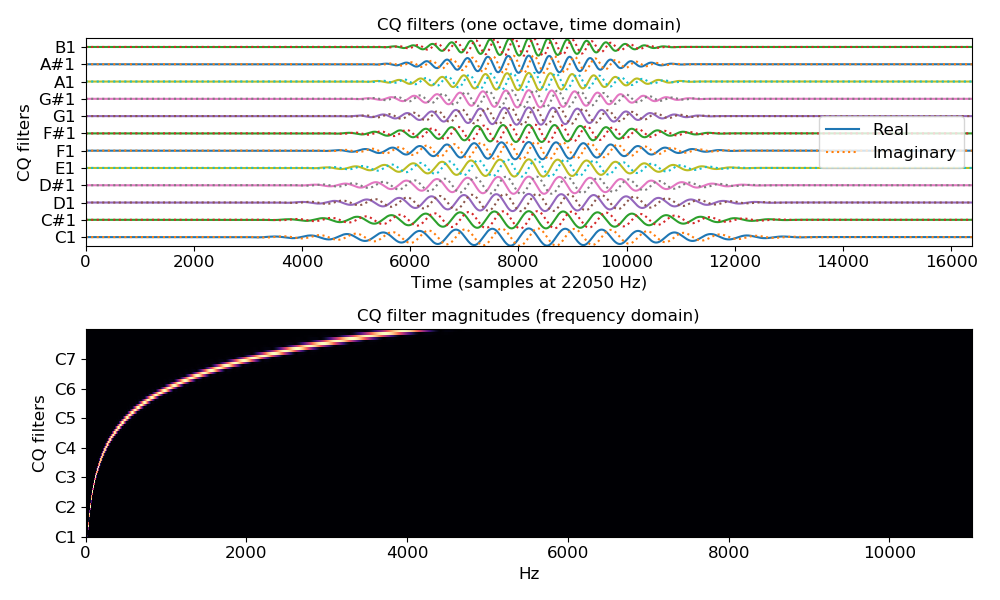librosa.filters.constant_q¶
-
librosa.filters.constant_q(sr, fmin=None, n_bins=84, bins_per_octave=12, tuning=0.0, window=’hann’, filter_scale=1, pad_fft=True, norm=1, **kwargs)[source]¶ Construct a constant-Q basis.
This uses the filter bank described by [1].
[1] McVicar, Matthew. “A machine learning approach to automatic chord extraction.” Dissertation, University of Bristol. 2013. Parameters: - sr : number > 0 [scalar]
Audio sampling rate
- fmin : float > 0 [scalar]
Minimum frequency bin. Defaults to C1 ~= 32.70
- n_bins : int > 0 [scalar]
Number of frequencies. Defaults to 7 octaves (84 bins).
- bins_per_octave : int > 0 [scalar]
Number of bins per octave
- tuning : float in [-0.5, +0.5) [scalar]
Tuning deviation from A440 in fractions of a bin
- window : string, tuple, number, or function
Windowing function to apply to filters.
- filter_scale : float > 0 [scalar]
Scale of filter windows. Small values (<1) use shorter windows for higher temporal resolution.
- pad_fft : boolean
Center-pad all filters up to the nearest integral power of 2.
By default, padding is done with zeros, but this can be overridden by setting the mode= field in kwargs.
- norm : {inf, -inf, 0, float > 0}
Type of norm to use for basis function normalization. See librosa.util.normalize
- kwargs : additional keyword arguments
Arguments to np.pad() when pad==True.
Returns: - filters : np.ndarray, len(filters) == n_bins
filters[i] is ith time-domain CQT basis filter
- lengths : np.ndarray, len(lengths) == n_bins
The (fractional) length of each filter
Notes
This function caches at level 10.
Examples
Use a shorter window for each filter
>>> basis, lengths = librosa.filters.constant_q(22050, filter_scale=0.5)
Plot one octave of filters in time and frequency
>>> import matplotlib.pyplot as plt >>> basis, lengths = librosa.filters.constant_q(22050) >>> plt.figure(figsize=(10, 6)) >>> plt.subplot(2, 1, 1) >>> notes = librosa.midi_to_note(np.arange(24, 24 + len(basis))) >>> for i, (f, n) in enumerate(zip(basis, notes[:12])): ... f_scale = librosa.util.normalize(f) / 2 ... plt.plot(i + f_scale.real) ... plt.plot(i + f_scale.imag, linestyle=':') >>> plt.axis('tight') >>> plt.yticks(np.arange(len(notes[:12])), notes[:12]) >>> plt.ylabel('CQ filters') >>> plt.title('CQ filters (one octave, time domain)') >>> plt.xlabel('Time (samples at 22050 Hz)') >>> plt.legend(['Real', 'Imaginary'], frameon=True, framealpha=0.8) >>> plt.subplot(2, 1, 2) >>> F = np.abs(np.fft.fftn(basis, axes=[-1])) >>> # Keep only the positive frequencies >>> F = F[:, :(1 + F.shape[1] // 2)] >>> librosa.display.specshow(F, x_axis='linear') >>> plt.yticks(np.arange(len(notes))[::12], notes[::12]) >>> plt.ylabel('CQ filters') >>> plt.title('CQ filter magnitudes (frequency domain)') >>> plt.tight_layout()
